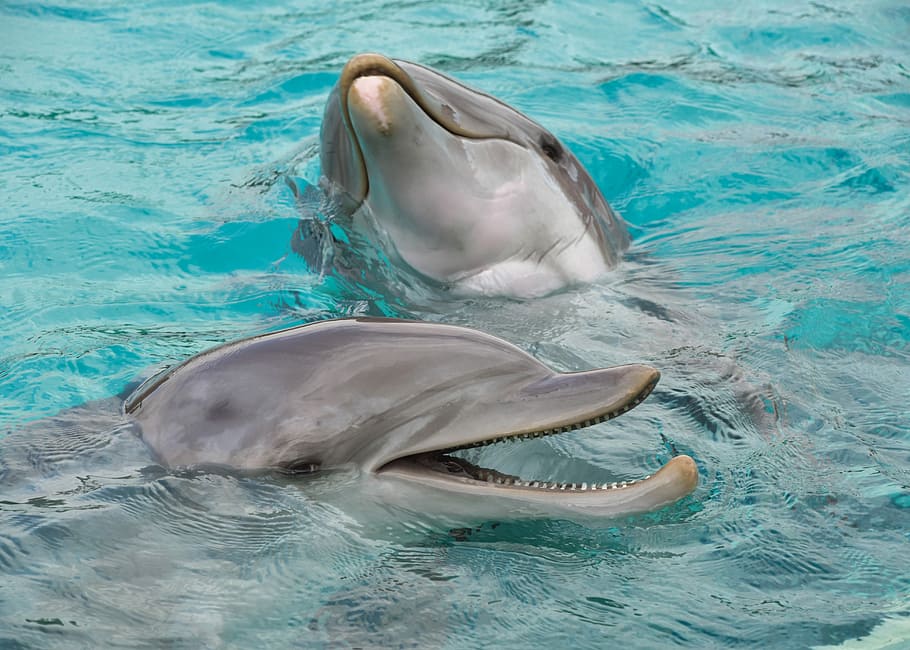
Why Bottlenose Dolphins Are Mammals? Bottlenose dolphins are mammals because they give birth to live young and nurse them with milk.
Bottlenose dolphins are fascinating creatures that inhabit oceans and coastal waters around the world.
Their distinct physical characteristics, lively demeanor, and intelligence are well recognized.
The fact that bottlenose dolphins are mammals and share the same class as people, dogs, and whales is one fascinating fact about them.
This classification is predicated on a number of important traits.
First, instead of laying eggs, bottlenose dolphins, like all mammals, give birth to live babies. They also have mammary glands, which secrete milk to feed their young while they are nursing.
They differ from other aquatic animals like fish and reptiles because of their characteristics. Moreover, dolphins also have warm-blooded metabolisms, which means that their body temperature doesn’t fluctuate much.
They can survive in a variety of oceanic conditions, including both warm and cold seas, thanks to this adaptation. Dolphins must frequently surface to breathe since they are airborne creatures with lungs.
Bottlenose dolphins are aquatic animals, although they have many physiological traits with land mammals. The fact that they are categorized as mammals emphasizes how related all life on Earth is. [Why Bottlenose Dolphins Are Mammals?]
Table of Contents
Classification Of Bottlenose Dolphins
The genus Tursiops and family Delphinidae are home to bottlenose dolphins. They belong to the class Mammalia, the order Cetacea, the phylum Chordata, and the animal kingdom.
They have certain traits in common with other animals in their class.
| Kingdom | Animalia |
| Phylum | Chordata |
| Class | Mammalia |
| Order | Cetacea |
| Family | Delphinidae |
| Genus | Tursiops |
| Species | Tursiops truncatus (common bottlenose dolphin) |
Bottlenose dolphins have sleek, grayish skin and a streamlined body with a bent dorsal fin. Their distinctive look is due to their rostrum, a nose that resembles a beak.
They are well-known for both their fast swimming and lighthearted nature.
Furthermore, their heads feature a blowhole that enables them to inhale air upon rising to the surface. They use their strong, cone-shaped teeth to grab and consume squid and fish. [Why Bottlenose Dolphins Are Mammals?]
Traits Of Mammals
Because of their unique characteristics—such as having hair or fur on their bodies, giving birth to live young, and nursing their young with milk—bottlenose dolphins are classified as mammals.
These features set them apart from other aquatic creatures such as fish or reptiles.

Warm-bloodedness
Like all mammals, bottlenose dolphins have warm blood. This implies that they are capable of controlling their body temperature internally, independent of environmental factors.
They can survive in a range of maritime habitats because their body keeps a steady temperature.
Mammary Glands And Milk Production
The existence of mammary glands is one of the traits that distinguish mammals. As mammals, bottlenose dolphins have these glands that allow them to make milk for their young.
The milk offers vital nutrition and illness prevention due to its high content of minerals and antibodies.
Fur or Hair
All mammals, including bottlenose dolphins, have hair follicles when they are embryonic, even though they do not have hair or fur on display.
Eventually, before giving birth, these follicles retreat, leaving dolphins hairless. Dolphins are not unique among mammals in having smooth skin. [Why Bottlenose Dolphins Are Mammals?]
Birthing Live Young
Mammals also have the trait of producing living offspring as opposed to laying eggs. In bottlenose dolphins, the mother gives birth to a single calf following a gestation period of around 12 months.
The birth occurs in the water, and the calf’s instant ability to breathe and swim demonstrates that it is a mammalian.
Dolphin Adaptations To Marine Life
Streamlined Body Shape: The streamlined body shape of bottlenose dolphins allows them to swim quickly through the water. Their streamlined form minimizes resistance and enables them to swim effectively.
Blubber for Insulation: Dolphins use a thick layer of blubber under their skin as insulation. They have energy reserves and are kept warm in cold water by this layer of fat acting as insulation.
Advanced Sonar mechanism: Dolphins travel and locate prey using an advanced sonar mechanism called echolocation. [Why Bottlenose Dolphins Are Mammals?]
By making high-frequency click sounds and listening for echoes that return, they are able to map their environment in great detail within their minds.
Evolutionary History Of Dolphins
Dolphins are amazing animals that have evolved over millions of years, especially bottlenose dolphins.
They share common ancestors with land-dwelling animals in their evolutionary history. As a result of multiple rounds of adaptation, they have acquired the distinctive traits that set them apart as mammals.
| Common Ancestors | Dolphin Evolutionary Timeline |
| Dolphins and terrestrial mammals have common ancestors about 50 million years ago. These primitive forebears most likely resembled little, four-legged aquatic critters. | 35 million years ago |
| These land-dwelling mammals eventually made their way into the water and adapted to live in the water. To survive in the marine environment, they progressively evolved traits like flippers, streamlined bodies, and specialized respiratory systems. | |
| These adaptations eventually led to the emergence of early dolphin species, which continued to evolve and diversify into the species we know today. | Present |
Dolphins’ remarkable capacity for adaptation and environmental survival is demonstrated by their evolutionary journey.
Understanding their beginnings and growth will help us to recognize the special position they have within the animal kingdom. [Why Bottlenose Dolphins Are Mammals?]
Frequently Asked Questions For Why Bottlenose Dolphins Are Mammals?
Why Are Bottlenose Dolphins Considered Mammals?
Since they possess every trait of a mammal, bottlenose dolphins are classified as mammals. They have hair on their body, give birth to living children, and nurse them with milk. They also have a blowhole on top of their skulls, just like humans, through which they breathe.
Do All Dolphins Belong To The Mammal Group?
Yes, every species of dolphin is a member of the mammal family. Dolphins are similar to other animals in that they are able to give birth to live offspring, nurse their young with milk, and breathe air through their lungs. They differ from fish or reptiles because of these characteristics.
How Are Dolphins Different From Fish?
Fish and dolphins are not the same in a few ways. Dolphins are air-breathing mammals with lungs rather than gills, unlike fish. They conceive live offspring and provide them with milk for nursing. Dolphins are renowned for their intellect and social skills, and they also have highly developed brains.
What Is The Lifespan Of A Bottlenose Dolphin?
Although some have been known to live longer, bottlenose dolphins typically live at least 40 years. The lifespan can vary based on a number of variables, including exposure to human activity, the presence of predators, and the availability of food. [Why Bottlenose Dolphins Are Mammals?]
Conclusion
In summary, bottlenose dolphins are categorized as mammals because of a number of important traits.
Mammals are distinguished by their capacity to give birth to live young, to feed their offspring with milk, and to have hair, albeit sparse.
They are incredibly fascinating organisms because of their ability to adapt to an aquatic habitat as well as their exceptional intelligence and social behavior.
We can better appreciate the intricate beauty of these amazing sea species if we recognize them as mammals.

Mr. Das, a certified pharmaceutical scientist, holds a Bachelor of Science in Pharmaceutical Sciences and passionately contributes to dolphin conservation as a member of the committee in Bangladesh.


